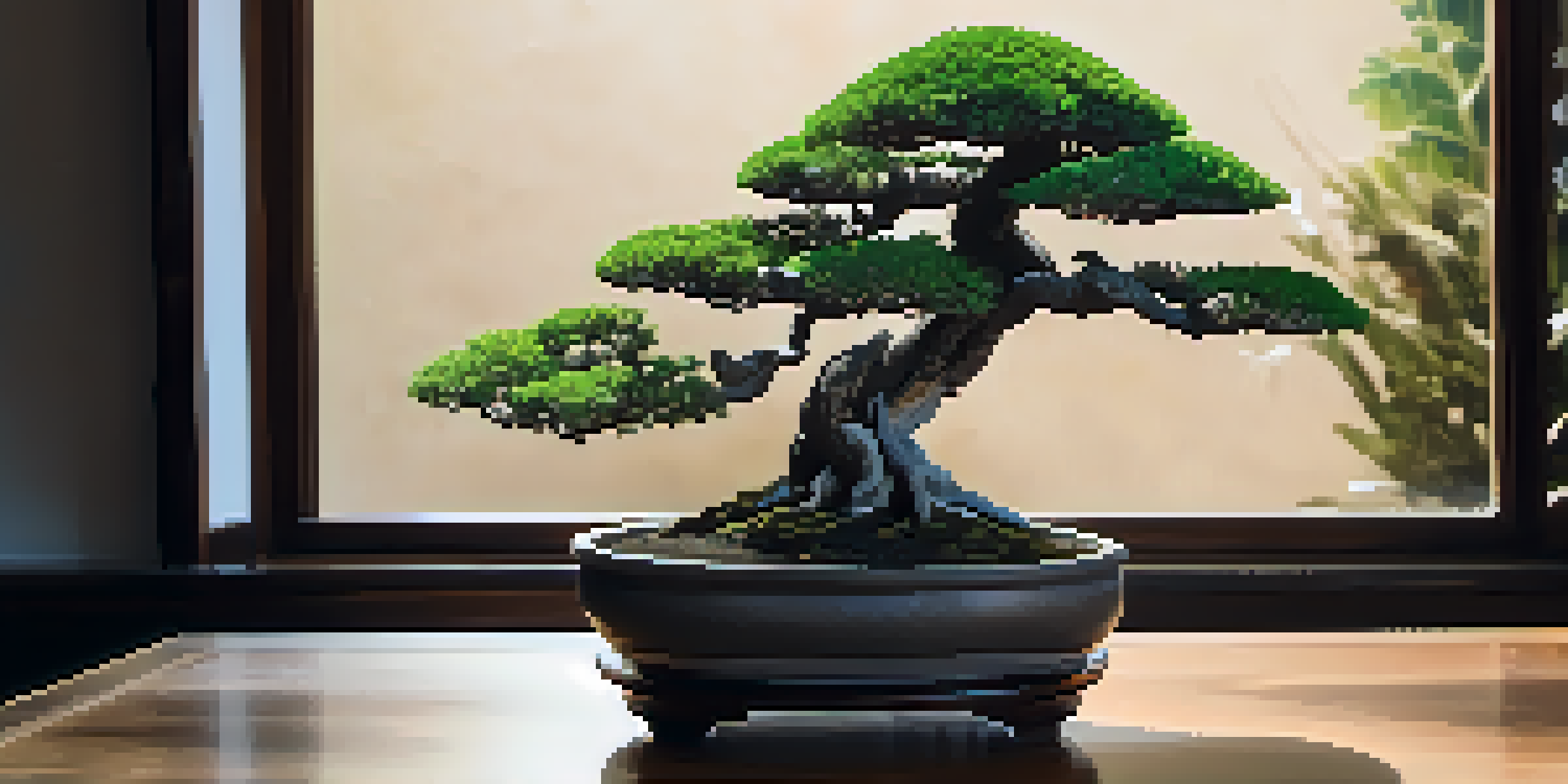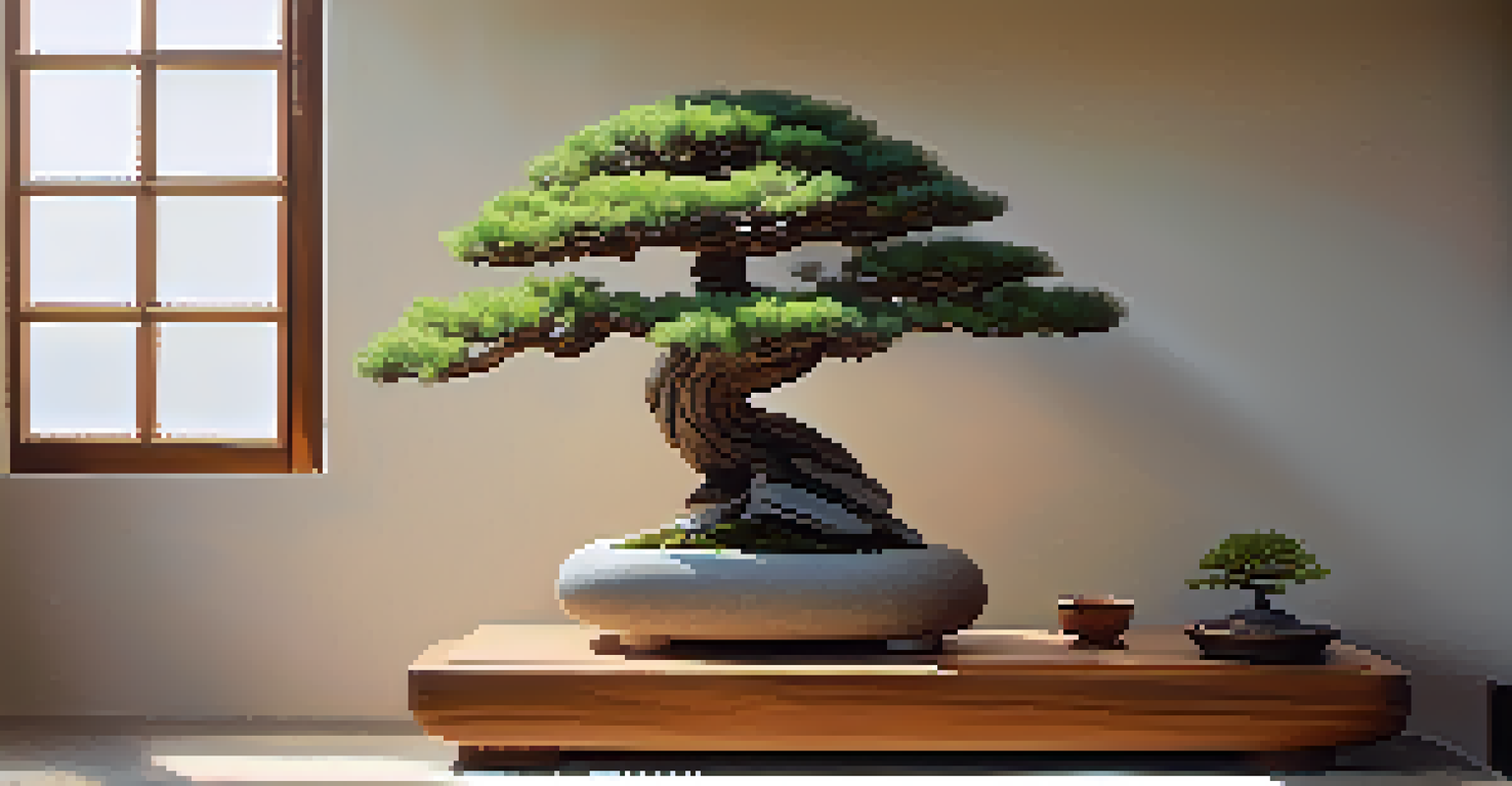The Basics of Bonsai Soil: Composition and Benefits

What is Bonsai Soil and Why is it Important?
Bonsai soil is a specially formulated mix designed to support the unique needs of bonsai trees. Unlike regular potting soil, bonsai soil promotes optimal drainage, aeration, and nutrient retention. This is crucial because bonsai trees are often kept in small pots, where the soil can easily become compacted and waterlogged.
The soil is the foundation of your bonsai tree's health and vitality.
The right soil mix helps mimic a tree's natural environment, allowing for healthy root development. Healthy roots mean a thriving tree, which is the ultimate goal for any bonsai enthusiast. By understanding the importance of bonsai soil, you can significantly enhance the longevity and beauty of your tree.
Investing time in selecting the right soil composition will pay off in the long run. A well-chosen mix not only keeps your bonsai tree healthy but also simplifies care and maintenance. This foundational step is essential for both beginners and seasoned bonsai growers.
Key Components of Bonsai Soil: An Overview
Bonsai soil typically consists of a blend of several key components, including akadama, pumice, and lava rock. Akadama, a clay-like substance, retains moisture while allowing excess water to drain away. Pumice adds aeration and helps keep the soil loose, which prevents compaction and root suffocation.

Lava rock, on the other hand, provides excellent drainage and adds weight to the mix, helping to stabilize the tree in its pot. Together, these components create an ideal environment for bonsai trees to thrive. Each element plays a role in balancing moisture, aeration, and nutrients.
Importance of Bonsai Soil
Bonsai soil is essential for promoting drainage, aeration, and nutrient retention, which are crucial for the health of bonsai trees.
It's also worth noting that different species of bonsai may require slight adjustments to the soil mix. For example, some trees may prefer a more moisture-retentive blend, while others thrive in a drier environment. Understanding the specific needs of your bonsai can lead to better growth and vitality.
The Role of Drainage in Bonsai Soil Composition
Good drainage is a fundamental aspect of bonsai soil, ensuring that water flows freely and doesn't pool around the roots. Excess water can lead to root rot, a common issue that can severely damage or even kill a bonsai tree. Therefore, incorporating materials that facilitate drainage is essential.
Just like a tree needs roots to grow, a bonsai needs the right soil to thrive.
The porous nature of components like pumice and lava rock allows water to escape while retaining some moisture needed for the tree’s health. This balance is crucial, as bonsai trees need to dry out slightly between watering to prevent waterlogging. Regularly checking drainage will help you adjust watering practices accordingly.
In addition to preventing root rot, proper drainage encourages healthy root growth. When roots can breathe and access air, they develop stronger and more extensive systems, which ultimately supports the overall health of the tree. By prioritizing drainage in your soil choice, you set the stage for a thriving bonsai.
Nutrient Retention: Feeding Your Bonsai Soil
While bonsai soil is designed to drain well, it also needs to retain some nutrients for the tree's growth. Nutrient retention is influenced by the soil components you choose; for instance, akadama helps hold onto essential nutrients while still providing drainage. This makes it a popular choice for many bonsai enthusiasts.
In addition to the soil mix, regular fertilization is crucial for maintaining nutrient levels. Bonsai trees often require more frequent feeding than regular houseplants due to their limited soil volume. Using a balanced fertilizer, especially during the growing season, ensures your bonsai receives the nutrients it needs to thrive.
Key Soil Components Explained
A proper bonsai soil mix typically includes akadama, pumice, and lava rock, each contributing to the tree's moisture and drainage needs.
Ultimately, understanding how nutrient retention works in bonsai soil can help you make informed decisions about care and maintenance. By combining a quality soil mix with a strategic feeding regimen, you can promote vibrant growth and stunning foliage in your bonsai.
Choosing the Right Soil for Different Bonsai Species
Different bonsai species have varying needs when it comes to soil composition. For example, tropical bonsai trees often prefer a more moisture-retentive mix, while coniferous species thrive in a drier environment. Understanding these differences can greatly improve your success in caring for your bonsai.
Researching the specific requirements of your bonsai species will help you select the right soil components. Some growers even customize their mixes based on their local climate and humidity levels. Tailoring your soil to your tree's needs ensures that it has the best chance to flourish.
When in doubt, don’t hesitate to consult with local bonsai experts or join community forums. Sharing knowledge with fellow enthusiasts can provide valuable insights into the best soil mixes for your specific bonsai. Remember, the right soil is a key ingredient in the recipe for a healthy, beautiful bonsai.
Common Mistakes in Bonsai Soil Selection
One of the most common mistakes beginners make is using regular potting soil for their bonsai trees. This type of soil often retains too much water, leading to root rot and other issues. It's vital to understand that bonsai trees have unique needs and require a specialized soil mix.
Another pitfall is neglecting to adjust soil composition based on seasonal changes. For instance, during the growing season, trees may need more moisture, while in winter, a drier mix might be more beneficial. Being attentive to these changes can help you maintain a healthy bonsai.
Avoid Common Soil Mistakes
Using regular potting soil and neglecting soil maintenance can lead to issues like root rot, undermining the health of bonsai trees.
Finally, many enthusiasts overlook the importance of regular soil replacement. Over time, the components in bonsai soil can break down, reducing aeration and drainage. By repotting your bonsai every few years and refreshing the soil, you'll help ensure a thriving environment for your tree.
Maintaining Your Bonsai Soil: Tips for Success
Maintaining the right soil conditions is key to the health of your bonsai. Regularly checking the moisture level is essential; the top layer should dry out before watering again. This practice not only prevents waterlogging but also encourages healthy root growth.
Additionally, it's important to monitor the soil's nutrient levels. Incorporating organic fertilizers can supplement the nutrients that may be depleted over time. A balanced approach to feeding will help your bonsai thrive and showcase its natural beauty.

Lastly, don't forget to observe your tree for signs of distress. If leaves are yellowing or dropping, it may indicate soil issues. By staying attuned to your bonsai's needs and making adjustments as necessary, you'll cultivate a strong, healthy tree for years to come.